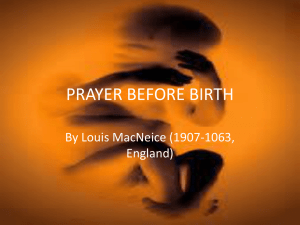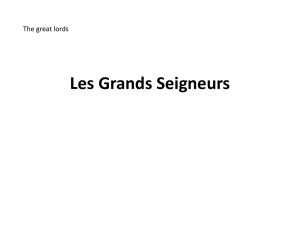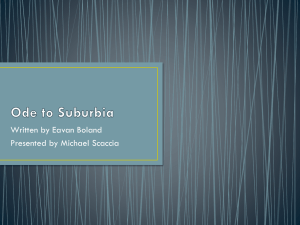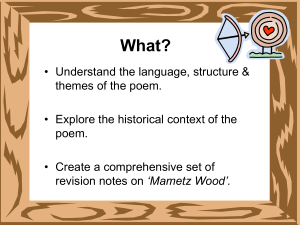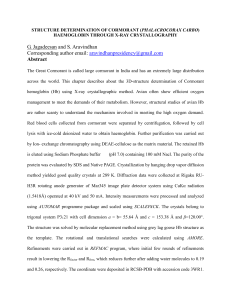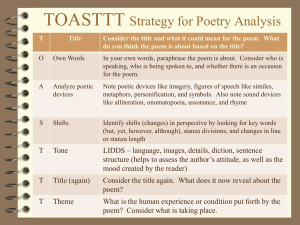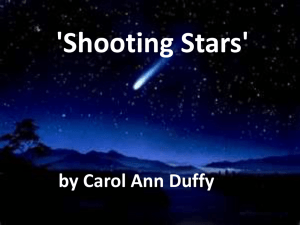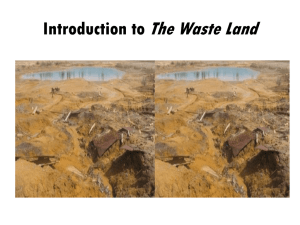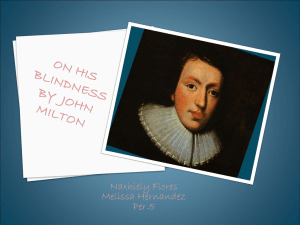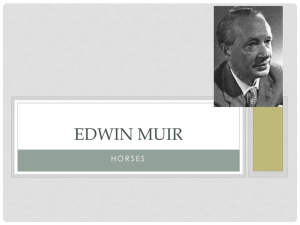Lament presentation
advertisement
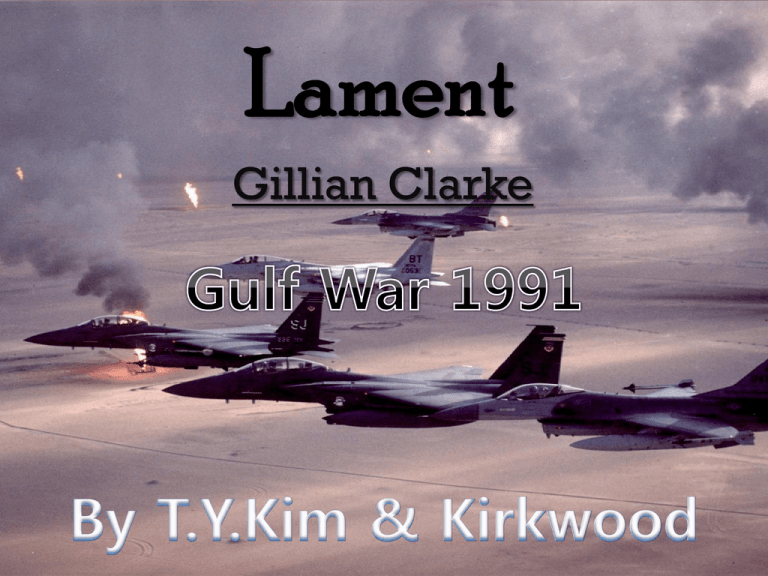
Lament Gillian Clarke • Born in 8 June 1937 in Cardiff, Wales • Poet, playwright, editor, translator (from Welsh), President of Ty Newydd, the writers´ centre in North Wales which she co-founded in 1990. Tutor on M.Phil. course in Creative Writing, the University of Glamorgan, since 1994. • Freelance tutor of creative writing, primary schools to adults. • Her work has been translated into 10 languages. Lament For the green turtle with her pulsing burden, In search of the breeding-ground. For her eggs laid in their nest of sickness. For the hook-beaked turtles, The dugong and the dolphin, The whale struck dumb by the missile’s thunder. For the cormorant in his funeral silk. The veil of iridescence on the sand, The shadow of the sea. For the tern the gull and the restless wader, The long migrations and the slow dying, The veiled sun and the stink of anger. For the ocean’s lap with its mortal stain. For the Ahmed at the closed border. For the soldier in his uniform of fire. For the burnt earth and the sun put out, The scalded ocean and the blazing well. For vengeance, and the ashes of language. For the gunsmith and the armourer, The boy fusilier who joined for the company, The farmer’s sons in it for the music. Gillian Clarke laments for the damages created by humans to the environment and animals people and animals who were injured or killed. “War can’t be waged without grave damage to every aspect of life.” It should be noted that all the details in the poem came from the reports in the media e.g. newspapers and radio broadcasts. Stanza one – laments for the green turtle not being able to find a nesting place. Stanza two – laments for the cormorant covered up in oil slick. Stanza three – laments for the contamination of the ocean, and also the people who are unable to cross ‘closed border’ Stanza four – looks at the human part of the war, laments for the human loss & cruelty of war. Stanza five – laments for the hook-beaked turtles, dugong and the dolphin with the mention of missiles. Stanza six – migratory birds having to change their original route because you can’t possibly rest in Gulf Stanza seven – laments for the Earth and the sun; and the allusion of government, blaming on the vengeance. Lament : elegy or a mourning of the passing of someone or something. Each item introduced by the preposition ‘for’ is being mourned. A lament or lamentation is a song, poem, or piece of music expressing grief, regret, or mourning. For the green turtle with her pulsing burden, In search of the breeding ground. For her eggs laid in their nest of sickness. metaphor 1. Green turtle - setting 2. ‘pulsing burden’ – suggests liveliness and bitterness. 3. ‘her eggs’ – the feminine words to suggest weakness 4. ‘nest of sickness’ – metaphor. 5. idea of suffering For the cormorant in his funeral silk. the veil of iridescence on the sand, the shadow on the sea. 1. connotations of greediness in the ‘cormorant’ 2. ‘funeral silk’. link between silk & oil 3. personification of the sand. (Also a metaphor) 4. negative tone on the shadow. For the ocean’s lap, with its mortal stain. For Ahmed at the closed border. Idea of Stain For the soldier in his uniform of fire. • Personification – on the ocean. • Use of a common Middle East name ‘Ahmed’ • suggests idea of entrapped/suffocating – ‘closed border’ & ‘uniform of fire’ • Technique – listing is used. ‘For….. For….. For…..’ should be noted. • use of metaphor for oil – the stain. • general motif of agony/ suffering/ violence. For the gunsmith and the armourer, the boy fusilier who joined for the company, the farmer’s sons in it for the music. • Innocent lives being wasted is portrayed in this stanza. • Listing of people, looks at the human part. • ‘Music’ = sarcasm, or euphemism of the glory/ adventure of war. • Are these people to be mourned? Does this show the cruelty of the war? For the hook-beaked turtles, The dugong and the dolphin, The whale struck dumb by the missile’s thunder. • mentions lots of specific water animals found in Gulf. • listing – laments for all those breeds • also shows confusion. Moreover shows the idea of no communication and no language • Auditory image/ metaphor used by the author For the tern, the gull and the restless wader, the long migrations and the slow dying, the veiled sun and the stink of anger. • listing of migratory birds • assonance : ‘long … slow’ • foreshadows next stanza with mentions of the metaphors of ‘sun’ and ‘anger’ • ‘veiled sun’ = death of light, symbolises death of innocence. • synaesthesia – smell causes anger. • destructivity of war explicitly shown For the burnt earth and the sun put out, The scalded ocean and the blazing well. For vengeance, and the ashes of language. revenge Remnants/ aftermath • Hyperbole – descriptions of the Earth, the Sun and the ocean. • ‘blazing well’ – burning oil wells which was bombed deliberately by the US. • Idea of aftermath – remnants ‘ash’ and the whole cause it being ‘vengeance’ • Breakdown of civilisation and means of communication – death of behaviour. 1. Lament – for the damages created by humans to the environment and eco-sys tems (including impacts to humans) 2. Sorrow & regret of the foolishness/ inhumanity of humans 3. Failure of communication, breakdown of civilised behaviour. 4. “Crossing a threshold” • Note that this poem doesn’t have a specific rhyme scheme or anything. The stanzas are in triplets, 7 ends stops. • It seems that ‘For’ is the main emphasis in the poem. By using anaphora, Clarke is able to produce a listing tone of things to lament ‘for’ and it should be taken into consideration that ‘For’ also connotates a sense of sympathy for all those animals and innocent human beings. This makes sense because the whole poem is based on newspaper articles and radio hearings. • Green turtle embodies innocence in the poem. They have done nothing wrong and yet the turtles needs to suffer from the damages of war. • The Cormorant symbolises greed and selfishness of the humans in the poem because a cormorant is known for stealing other birds’ food and being lazy. • The boy fusilier is also a victim of this war. • If you look at it in these ways, all the animals mentioned in the poem are pretty much all symbols. 1. Explore the ways in which Gillian Clarke effectively creates the bitter tone in th e poem lament. 2. Discuss how the poet uses different language techniques to lament for all the innocent beings mentioned in the poem. 3. With reference to this poem and The Voice and Amends, explain how the poems are linked by common themes and ideas. Surely, looking at photos like these on newspapers would have inspired Clarke enough to write a poem to express her lament
